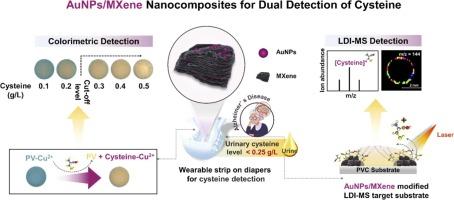基于AuNPs/MXene纳米复合材料的半胱氨酸双重检测:比色传感器和“咖啡环”增强LDI-MS用于阿尔茨海默病筛查
IF 3.7
1区 化学
Q1 CHEMISTRY, ANALYTICAL
引用次数: 0
摘要
我们报道了一种新型金纳米颗粒/MXene (AuNPs/MXene)纳米复合材料的合成和应用,该复合材料被设计为双信号平台,用于敏感和选择性检测半胱氨酸,半胱氨酸是阿尔茨海默病的关键生物标志物。该纳米复合材料具有以下功能:(1)在邻苯二酚紫/硫酸铜(PV/CuSO₄)比色法中具有有效的信号放大功能,可进行快速视觉筛选;(2)用于激光解吸/电离质谱(LDI-MS)的高性能基质,可实现精确定量。该纳米复合材料在溶剂蒸发过程中浓缩了半胱氨酸,显著提高了比色强度。对于LDI-MS, AuNPs对巯基的高亲和力和MXene的多层结构的协同结合促进了异常的半胱氨酸富集,对常见尿液干扰物的选择性和高电离效率,与传统基质相比,导致离子丰度显著增加(m/z 120.02)。AuNPs/MXene的固有选择性最大限度地减少了低质量基质干扰(<500 Da),而咖啡环效应确保了高的点对点重现性。这种集成的双模式方法可以在阿尔茨海默病筛查的临床相关范围内(≥0.25 g L - 1)直接检测人尿中的半胱氨酸,具有很高的灵敏度和选择性。至关重要的是,我们通过在纸尿裤内集成的聚氯乙烯(PVC)上实现选择性半胱氨酸检测,证明了该平台的实用性,为实现方便、实时疾病监测的可穿戴、非侵入性诊断工具迈出了重要一步。本文章由计算机程序翻译,如有差异,请以英文原文为准。

AuNPs/MXene Nanocomposite-Based Dual Detection of Cysteine: Colorimetric Sensor and "Coffee Ring" Augmented LDI-MS for Alzheimer's Screening
We report the synthesis and application of a novel gold nanoparticle/MXene (AuNPs/MXene) nanocomposite engineered as a dual-signal platform for the sensitive and selective detection of cysteine, a key biomarker for Alzheimer's disease. This nanocomposite functions as (1) a potent signal amplification in a pyrocatechol violet/copper sulfate (PV/CuSO₄) colorimetric assay for rapid visual screening, and (2) a high-performance matrix for laser desorption/ionization mass spectrometry (LDI-MS) enabling precise quantification. The nanocomposite concentrates cysteine during solvent evaporation, significantly enhancing colorimetric intensity. For LDI-MS, the synergistic combination of AuNPs' high affinity for thiol groups and MXene's multi-layered structure facilitates exceptional cysteine enrichment, selectivity against common urinary interferents, and high ionization efficiency, resulting in markedly increased ion abundance (m/z 120.02) compared to conventional matrices. The inherent selectivity of AuNPs/MXene minimizes low-mass matrix interferences (<500 Da), while the coffee-ring effect ensures high spot-to-spot reproducibility. This integrated dual-mode approach achieves direct detection of cysteine in human urine within the clinically relevant range for Alzheimer's disease screening (≥0.25 g L⁻¹), demonstrating high sensitivity and selectivity. Crucially, we demonstrate the platform's practicality by achieving selective cysteine detection on polyvinyl chloride (PVC) integrated within a diaper, establishing a significant step towards wearable, non-invasive diagnostic tools for convenient, real-time disease monitoring.
求助全文
通过发布文献求助,成功后即可免费获取论文全文。
去求助
来源期刊

Sensors and Actuators B: Chemical
工程技术-电化学
CiteScore
14.60
自引率
11.90%
发文量
1776
审稿时长
3.2 months
期刊介绍:
Sensors & Actuators, B: Chemical is an international journal focused on the research and development of chemical transducers. It covers chemical sensors and biosensors, chemical actuators, and analytical microsystems. The journal is interdisciplinary, aiming to publish original works showcasing substantial advancements beyond the current state of the art in these fields, with practical applicability to solving meaningful analytical problems. Review articles are accepted by invitation from an Editor of the journal.
 求助内容:
求助内容: 应助结果提醒方式:
应助结果提醒方式:


